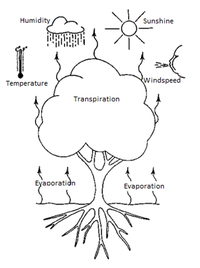Knowledge fuels change - Support energypedia!
For over 10 years, energypedia has been connecting energy experts around the world — helping them share knowledge, learn from each other, and accelerate the global energy transition.
Today, we ask for your support to keep this platform free and accessible to all.
Even a small contribution makes a big difference! If just 10–20% of our 60,000+ monthly visitors donated the equivalent of a cup of coffee — €5 — Energypedia would be fully funded for a whole year.
Is the knowledge you’ve gained through Energypedia this year worth €5 or more?
Your donation keeps the platform running, helps us create new knowledge products, and contributes directly to achieving SDG 7.
Thank you for your support, your donation, big or small, truly matters!
SPIS Toolbox - Water Availability

| ►Back to the Start Page | ►Back to the Module Page | ►Go to the Next Chapter |
Water Availability
This parameter investigates the amount and quality of water available for irrigation at a potential SPIS area. Irrigation water requirements depend on the balance of the crop water demand against the water availability.
Crop water demand may generally be defined as the amount of water needed for a plant to live and grow and is measured in millimeters per day, month or season. It is affected by various factors including:
- Climatic conditions including temperature, humidity and windspeeds. Consequently, water needs for one crop will vary with varying climatic conditions, with the highest demand seen in areas that are hot, dry, windy and sunny;
- The type of crop affects its water demand, both in the short term (daily water demand) and the longer term (seasonal water demand);
- The stage of growth for a particular crop also affects its water demand. For instance, a mature maize plant may demand more water than one at the shooting stage. Local data on crop water needs is often available with agricultural extension offices. The Water requirement tool under the SAFEGUARD WATER Module as well as resources provided by the FAO may also be used in estimating water demand.
Water availability for crop growth is dependent on three main sources: precipitation, ground water and surface water resources.
Precipitation, the amount of rainfall received in an area, has a direct influence on the need for irrigation within an area. If the amount of precipitation received within a region is enough to meet the water demands of the crops grown, irrigation is not necessary; when precipitation volumes are not adequate, water supply through irrigation from ground or surface water resources becomes critical for crop growth. The adequacy of precipitation may be evaluated by comparing the effective rainfall against the crop water demand using the SAFEGUARD WATER – Water Requirement Tool.
Effective rainfall – this looks at the amount of water from rainfall received within an area that is available for utilization by crops. This volume is affected by various factors including soil texture and structure, climate, topography and the depth of crops’ root zone among others. These factors consequently affect the rate of surface run-off and water percolation / infiltration beyond the root zone. The amount of rainwater retained in the root zone of plants that can be used by plants is referred to as effective rainfall. Most countries have developed tools to determine effective precipitation. However, in the absence of data (e.g. lack of prevailing soil type, rainfall reliability and topography data), the FAO provides rough estimates for effective rainfall per rainfall received.
Ground and surface water sources– the need to tap into these resources to meet the water deficit from rainfall introduces the market potential for SPIS. However, it is important to note that factors such as water source proximity and yield, aquifer recharge rates, water quality, water permits or rights required for abstraction among others must be taken into consideration when identifying and designing SPIS for specific areas. Water source yield, for example, has a direct influence on the type of irrigation method selected. In situations of inadequate water supply, sensitive soils or poor quality water (sedimentation, salinity and water hardness) appropriate methods like drip and sprinkler irrigation are preferred. Surface irrigation is preferred if the irrigation water contains large amounts of sediment which may clog the drip or sprinkler irrigation systems. This is expounded on in the DESIGN Module.
Outcome/Product
- Classification of regions based on crop water demand vs effective rainfall.
- Identification of ground and surface water sources.
Data Requirements
- Monthly Precipitation data
- Data on surface water bodies and ground water aquifer systems
- Water licensing and abstraction rights
- Water source flow rates
- Crop water demand
People/Stakeholders
- Meteorological Service Providers
- Water resource management authorities and abstraction licensing authorities
- Agricultural advisors and extension officers
- Irrigation boards and organisations
Important Issues
- Desktop analysis of precipitation and ground and surface water sources should be followed by verification of data from the relevant government bodies (e.g. national meteorological centres and water resources management authorities) prior to investment.
- Determination of crop water requirements can be done using the WATER REQUIREMENT TOOL in the Safeguard water module.
- Adoption of SPIS should ensure sustainable abstraction of water from identified water sources. The SAFEGUARD WATER module provides information on water resource management and sustainable water abstraction and provides a water resource management checklist.
| ►Back to the Start Page | ►Back to the Module Page | ►Go to the Next Chapter |




















